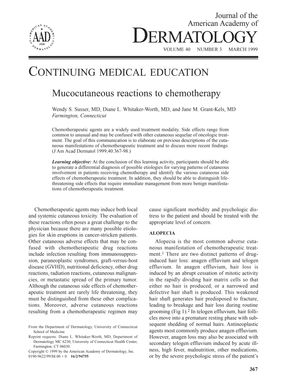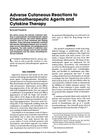Mucocutaneous Reactions to Chemotherapy
March 1999
in “
Journal of The American Academy of Dermatology
”
alopecia anagen effluvium telogen effluvium chemotherapy stomatitis extravasation pigmentary abnormalities acral erythema radiation recall reactions photosensitivity inflammation of keratoses hypersensitivity reactions neutrophilic eccrine hidradenitis eccrine squamous syringometaplasia Erythema Multiforme-like Eruptions Cutaneous Eruption of Lymphocyte Recovery hair loss chemotherapy-induced hair loss skin pigmentation changes skin reactions skin inflammation skin hypersensitivity

TLDR Chemotherapy can cause various skin reactions, with hair loss being the most common, and proper diagnosis and treatment of these reactions are important.
The document from 1999 details various mucocutaneous reactions to chemotherapy, including alopecia, stomatitis, extravasation, pigmentary abnormalities, acral erythema, radiation recall reactions, photosensitivity, inflammation of keratoses, hypersensitivity reactions, neutrophilic eccrine hidradenitis, eccrine squamous syringometaplasia, Erythema Multiforme-like Eruptions, and Cutaneous Eruption of Lymphocyte Recovery. It explains that alopecia is the most common cutaneous side effect, with anagen effluvium and telogen effluvium as two patterns, and that hair loss is generally reversible. Stomatitis affects about 40% of patients, and extravasation, which can lead to tissue damage, occurs in 0.1% to 6% of cases. The document also describes the effects of chemotherapy on skin pigmentation and the incidence and management of acral erythema. It highlights the importance of recognizing and treating radiation recall reactions, radiation enhancement, and interactions with ultraviolet light. Additionally, it discusses hypersensitivity reactions, including urticaria and anaphylaxis, and specific conditions like neutrophilic eccrine hidradenitis and eccrine squamous syringometaplasia. Finally, it notes that Erythema Multiforme-like Eruptions and Cutaneous Eruption of Lymphocyte Recovery are associated with chemotherapeutic agents, emphasizing the need for accurate diagnosis and treatment to reduce morbidity and mortality.





